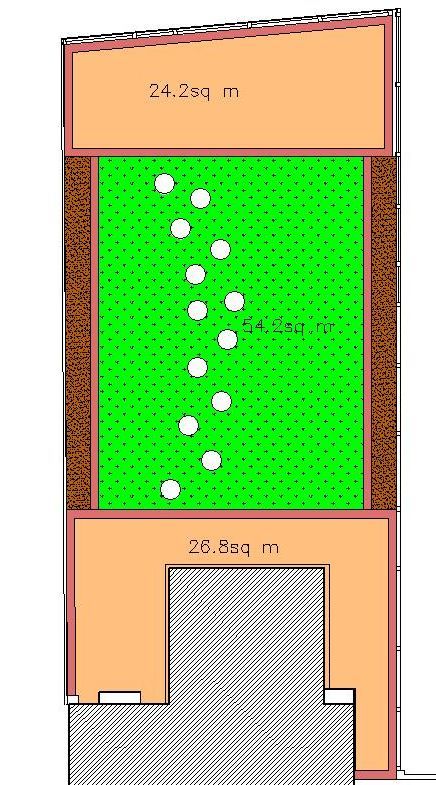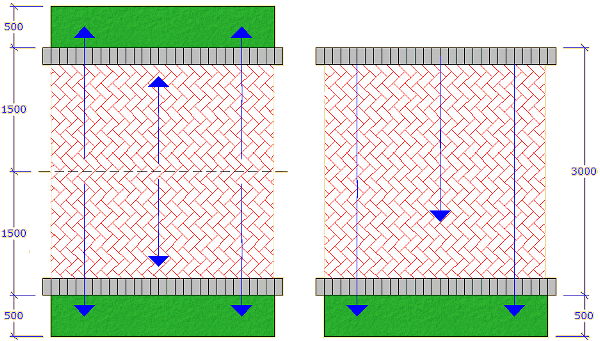Posted: Sat Mar 29, 2014 10:40 pm
Howdy,
I'm in the early stages of a major garden remodelling: replacing some rotten decking at the end with a patio, and replacing a badly laid patio (that's using the word generously) near the house with something a little better.
Neither decking or existing patio has any drainage, the existing patio, or collection of flagstones, is laid on mud and rubble.
My current plan involves imported sandstone (ebay bargain) so is pretty impermeable. There'll be a patio at the end of the garden, about 25sqm (8m wide x 3m) and a patio/wide path around the conservatory which sits midwayish along the rear elevation (end terrace). The house drains are combined, though our gutter actually drains into next doors downpipe as they are shared. There's a gulley at each corner of the rear elevation, however current thinking is that surface water should be disposed of elsewhere.
The soil is clay, but the back garden currently is not prone to flooding. It rises gently from the house, about 8m wide and 12m deep (from conservatory). I'd guess at the end of the garden being about 300-500mm higher. Between both paved areas will be lawn (about 57sq m). the conservatory is well constructed, but a little low, the current paving slabs are about 1 brick below the DPC on the dwarf wall.
So, enough waffle. My dilemma:
How do I adequately drain these two areas without massive expense?
Plan A: Linear drain around conservatory, discharging to a soakaway under the lawn. Second linear drain on top patio (Furthest edge, to avoid collecting lawn detritus) discharging to same soakaway. Soakaway size estimated to be 1.2 cubic metres (approx 45sqm patio in total). Both patios fall away from lawn.
Plan B: Land drain network under lawn to redistribute water flowing off patios, to avoid saturating lawn adjacent to paving edges. Both paved areas fall towards lawn.
Do either of the plans above have merit? My next task, after clearing the decking, will be a test pit to see how permeable the ground actually is, I guess that might answer this question. Assuming the worst case, what else could I do?
I'm in the early stages of a major garden remodelling: replacing some rotten decking at the end with a patio, and replacing a badly laid patio (that's using the word generously) near the house with something a little better.
Neither decking or existing patio has any drainage, the existing patio, or collection of flagstones, is laid on mud and rubble.
My current plan involves imported sandstone (ebay bargain) so is pretty impermeable. There'll be a patio at the end of the garden, about 25sqm (8m wide x 3m) and a patio/wide path around the conservatory which sits midwayish along the rear elevation (end terrace). The house drains are combined, though our gutter actually drains into next doors downpipe as they are shared. There's a gulley at each corner of the rear elevation, however current thinking is that surface water should be disposed of elsewhere.
The soil is clay, but the back garden currently is not prone to flooding. It rises gently from the house, about 8m wide and 12m deep (from conservatory). I'd guess at the end of the garden being about 300-500mm higher. Between both paved areas will be lawn (about 57sq m). the conservatory is well constructed, but a little low, the current paving slabs are about 1 brick below the DPC on the dwarf wall.
So, enough waffle. My dilemma:
How do I adequately drain these two areas without massive expense?
Plan A: Linear drain around conservatory, discharging to a soakaway under the lawn. Second linear drain on top patio (Furthest edge, to avoid collecting lawn detritus) discharging to same soakaway. Soakaway size estimated to be 1.2 cubic metres (approx 45sqm patio in total). Both patios fall away from lawn.
Plan B: Land drain network under lawn to redistribute water flowing off patios, to avoid saturating lawn adjacent to paving edges. Both paved areas fall towards lawn.
Do either of the plans above have merit? My next task, after clearing the decking, will be a test pit to see how permeable the ground actually is, I guess that might answer this question. Assuming the worst case, what else could I do?

